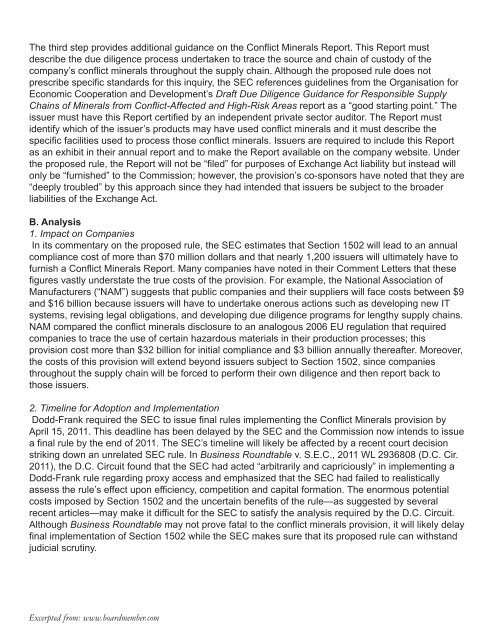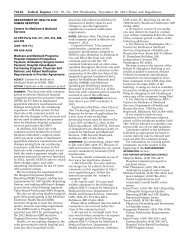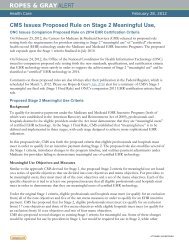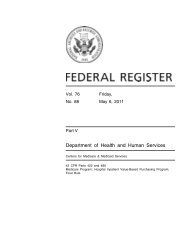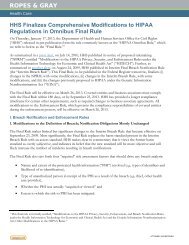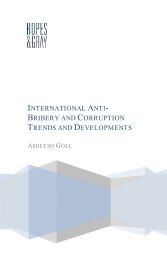Dodd-Frank and the Curious Case of Conflict Minerals - Ropes & Gray
Dodd-Frank and the Curious Case of Conflict Minerals - Ropes & Gray
Dodd-Frank and the Curious Case of Conflict Minerals - Ropes & Gray
Create successful ePaper yourself
Turn your PDF publications into a flip-book with our unique Google optimized e-Paper software.
The third step provides additional guidance on <strong>the</strong> <strong>Conflict</strong> <strong>Minerals</strong> Report. This Report mustdescribe <strong>the</strong> due diligence process undertaken to trace <strong>the</strong> source <strong>and</strong> chain <strong>of</strong> custody <strong>of</strong> <strong>the</strong>company’s conflict minerals throughout <strong>the</strong> supply chain. Although <strong>the</strong> proposed rule does notprescribe specific st<strong>and</strong>ards for this inquiry, <strong>the</strong> SEC references guidelines from <strong>the</strong> Organisation forEconomic Cooperation <strong>and</strong> Development’s Draft Due Diligence Guidance for Responsible SupplyChains <strong>of</strong> <strong>Minerals</strong> from <strong>Conflict</strong>-Affected <strong>and</strong> High-Risk Areas report as a “good starting point.” Theissuer must have this Report certified by an independent private sector auditor. The Report mustidentify which <strong>of</strong> <strong>the</strong> issuer’s products may have used conflict minerals <strong>and</strong> it must describe <strong>the</strong>specific facilities used to process those conflict minerals. Issuers are required to include this Reportas an exhibit in <strong>the</strong>ir annual report <strong>and</strong> to make <strong>the</strong> Report available on <strong>the</strong> company website. Under<strong>the</strong> proposed rule, <strong>the</strong> Report will not be “filed” for purposes <strong>of</strong> Exchange Act liability but instead willonly be “furnished” to <strong>the</strong> Commission; however, <strong>the</strong> provision’s co-sponsors have noted that <strong>the</strong>y are“deeply troubled” by this approach since <strong>the</strong>y had intended that issuers be subject to <strong>the</strong> broaderliabilities <strong>of</strong> <strong>the</strong> Exchange Act.B. Analysis1. Impact on CompaniesIn its commentary on <strong>the</strong> proposed rule, <strong>the</strong> SEC estimates that Section 1502 will lead to an annualcompliance cost <strong>of</strong> more than $70 million dollars <strong>and</strong> that nearly 1,200 issuers will ultimately have t<strong>of</strong>urnish a <strong>Conflict</strong> <strong>Minerals</strong> Report. Many companies have noted in <strong>the</strong>ir Comment Letters that <strong>the</strong>sefigures vastly understate <strong>the</strong> true costs <strong>of</strong> <strong>the</strong> provision. For example, <strong>the</strong> National Association <strong>of</strong>Manufacturers (“NAM”) suggests that public companies <strong>and</strong> <strong>the</strong>ir suppliers will face costs between $9<strong>and</strong> $16 billion because issuers will have to undertake onerous actions such as developing new ITsystems, revising legal obligations, <strong>and</strong> developing due diligence programs for lengthy supply chains.NAM compared <strong>the</strong> conflict minerals disclosure to an analogous 2006 EU regulation that requiredcompanies to trace <strong>the</strong> use <strong>of</strong> certain hazardous materials in <strong>the</strong>ir production processes; thisprovision cost more than $32 billion for initial compliance <strong>and</strong> $3 billion annually <strong>the</strong>reafter. Moreover,<strong>the</strong> costs <strong>of</strong> this provision will extend beyond issuers subject to Section 1502, since companiesthroughout <strong>the</strong> supply chain will be forced to perform <strong>the</strong>ir own diligence <strong>and</strong> <strong>the</strong>n report back tothose issuers.2. Timeline for Adoption <strong>and</strong> Implementation<strong>Dodd</strong>-<strong>Frank</strong> required <strong>the</strong> SEC to issue final rules implementing <strong>the</strong> <strong>Conflict</strong> <strong>Minerals</strong> provision byApril 15, 2011. This deadline has been delayed by <strong>the</strong> SEC <strong>and</strong> <strong>the</strong> Commission now intends to issuea final rule by <strong>the</strong> end <strong>of</strong> 2011. The SEC’s timeline will likely be affected by a recent court decisionstriking down an unrelated SEC rule. In Business Roundtable v. S.E.C., 2011 WL 2936808 (D.C. Cir.2011), <strong>the</strong> D.C. Circuit found that <strong>the</strong> SEC had acted “arbitrarily <strong>and</strong> capriciously” in implementing a<strong>Dodd</strong>-<strong>Frank</strong> rule regarding proxy access <strong>and</strong> emphasized that <strong>the</strong> SEC had failed to realisticallyassess <strong>the</strong> rule’s effect upon efficiency, competition <strong>and</strong> capital formation. The enormous potentialcosts imposed by Section 1502 <strong>and</strong> <strong>the</strong> uncertain benefits <strong>of</strong> <strong>the</strong> rule—as suggested by severalrecent articles—may make it difficult for <strong>the</strong> SEC to satisfy <strong>the</strong> analysis required by <strong>the</strong> D.C. Circuit.Although Business Roundtable may not prove fatal to <strong>the</strong> conflict minerals provision, it will likely delayfinal implementation <strong>of</strong> Section 1502 while <strong>the</strong> SEC makes sure that its proposed rule can withst<strong>and</strong>judicial scrutiny.Excerpted from: www.boardmember.com


